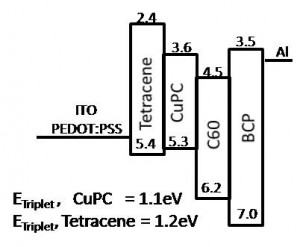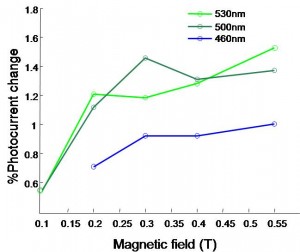Singlet exciton fission in organic solar cells

Figure 1: Device structure and energy levels. The CuPC triplet is slightly lower in energy than the tetracene triplet, allowing the triplets formed in tetracene to reach the interface. BCP prevents exciton quenching at the cathode.
The efficiency of solar cells is controlled by the energy gap of the constituent materials. The “single junction limit” is imposed because photons with energy higher than the gap lose energy in thermalization and those lower than the gap cannot be absorbed [1]. Tandem cells work around this limit by having more than one photovoltaic structure in parallel absorbing different parts of the solar spectrum. However, tandem cells are not economical in every material system, and so in this project we use singlet exciton fission to potentially surpass the single-junction efficiency limit.

Figure 2: Change in photocurrent with magnetic field as a function of excitation wavelength. No change was seen at red wavelengths.
Some organic materials, like the acenes (anthracene, tetracene and pentacene) exhibit singlet fission [2], in which a high energy singlet exciton spontaneously decomposes into two low energy triplets. We are investigating the novel device structure shown in Figure 1. It uses tetracene as a donor to generate high energy singlets in the λ = 450-550-nm region, which then split into two lower energy triplets, potentially doubling the photocurrent in this part of the spectrum. The presence of singlet fission in tetracene is confirmed by the magnetic field dependence of the photocurrent (Figure. 2). Harvesting of solar energy at longer wavelengths is performed by CuPC (copper phthalocyanine). Thus, this structure is capable of higher efficiencies.
References
- W. Shockley and H.J. Queisser, “Detailed Balance Limit of Efficiency of p‐n Junction Solar Cells,” Journal of Applied Physics, vol.32, pp. 510-519, Mar. 1961. [↩]
- R.E. Merrifield, P. Avakian and R.P. Groff, “Fission of singlet excitons into pairs of triplet excitons in tetracene crystals,” Chemical Physics Letters, vol.3, pp.386-388, June 1969. [↩]